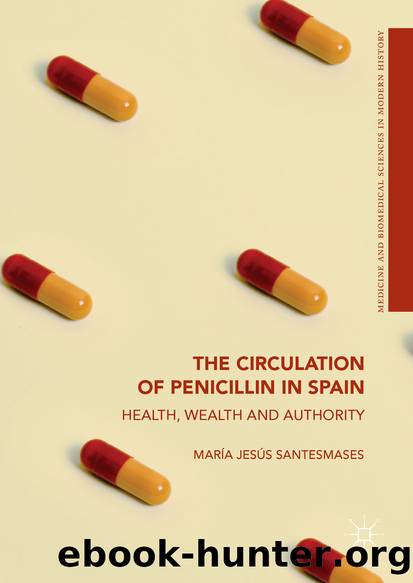The Circulation of Penicillin in Spain by María Jesús Santesmases

Author:María Jesús Santesmases
Language: eng
Format: epub
Publisher: Springer International Publishing, Cham
Industrial Connections
After developing the efficient production of penicillin as part of the war effort, Merck now owned patent rights to penicillin and streptomycin manufacture and had started to license them outside the USA. This was the stage for Merck’s expansion to Spain, the commercial agreement signed with a group of Spanish chemical and pharmaceutical companies belonging to Banco Urquijo in 1948, and the building of the penicillin production plant in Madrid , as detailed in Chap. 3.
At that time, the ‘comprehensive programme of screening Actynomicetes for their ability to produce different antibiotics’ had been successfully developed by Waksman’s research group at Rutgers. 42 The group collected soil samples , plated them out, isolated Actinomycetes and repeatedly tested for antibiotic activity against non-pathogenic strains of mycobacteria, in the hope of finding new substances active against pathogenic strains. 43 This seemingly simple project, the description of which could evoke routine and repetitive activity, was dutifully maintained at Waksman’s laboratories even through the 1950s, when there seemed to be a consensus—apparently not shared by Merck microbiologists—that no new antibiotics were required, given the amount already being manufactured following successful clinical trials . 44 However, the increasing resistance of bacteria to the activity of many antibiotics spurred on the hunt. The systematic study of soil preparations as a repetitive, planned programme was part of a microbiological strategy, closely associated with the meaning of ‘antibiotic’, a term coined by Waksman himself. 45
Previous commercial agreements between Merck and CEPA were managed by CEPA’s director, Antonio Gallego . Once the penicillin factory in Madrid was in operation, Gallego participated in establishing this ‘new research endeavour’ at CEPA’s laboratories using income from penicillin and streptomycin manufacturing licences. 46 The documents relating to this agreement, as well as testimonies provided by former CEPA colleagues, suggest Gallego was fully aware of the research programme developed by Merck’s Research Laboratory and Institute for Therapeutic Research, set up in 1938. 47 By the time the agreement was signed, in September 1954, a streptomycin plant was in full production; Waksman had attended the inauguration in Madrid on the tenth anniversary of the drug’s ‘discovery’ (Fig. 5.1). 48
Fig. 5.1 Selman Waksman with Antonio Gallego , left, and José Luis Gallego , right, at the CEPA streptomycin factory, Aranjuez 1954.
Courtesy of Roberto Gallego
Download
This site does not store any files on its server. We only index and link to content provided by other sites. Please contact the content providers to delete copyright contents if any and email us, we'll remove relevant links or contents immediately.
| Africa | Americas |
| Arctic & Antarctica | Asia |
| Australia & Oceania | Europe |
| Middle East | Russia |
| United States | World |
| Ancient Civilizations | Military |
| Historical Study & Educational Resources |
Room 212 by Kate Stewart(5077)
The Crown by Robert Lacey(4766)
Endurance: Shackleton's Incredible Voyage by Alfred Lansing(4725)
The Iron Duke by The Iron Duke(4325)
The Rape of Nanking by Iris Chang(4173)
Joan of Arc by Mary Gordon(4058)
Killing England by Bill O'Reilly(3974)
Say Nothing by Patrick Radden Keefe(3940)
I'll Give You the Sun by Jandy Nelson(3399)
Shadow of Night by Deborah Harkness(3327)
Hitler's Monsters by Eric Kurlander(3294)
Mary, Queen of Scots, and the Murder of Lord Darnley by Alison Weir(3177)
Blood and Sand by Alex Von Tunzelmann(3170)
Eleanor & Park by Rainbow Rowell(3120)
Darkest Hour by Anthony McCarten(3100)
Margaret Thatcher: The Autobiography by Thatcher Margaret(3053)
Book of Life by Deborah Harkness(2895)
Red Famine: Stalin's War on Ukraine by Anne Applebaum(2895)
The One Memory of Flora Banks by Emily Barr(2837)
